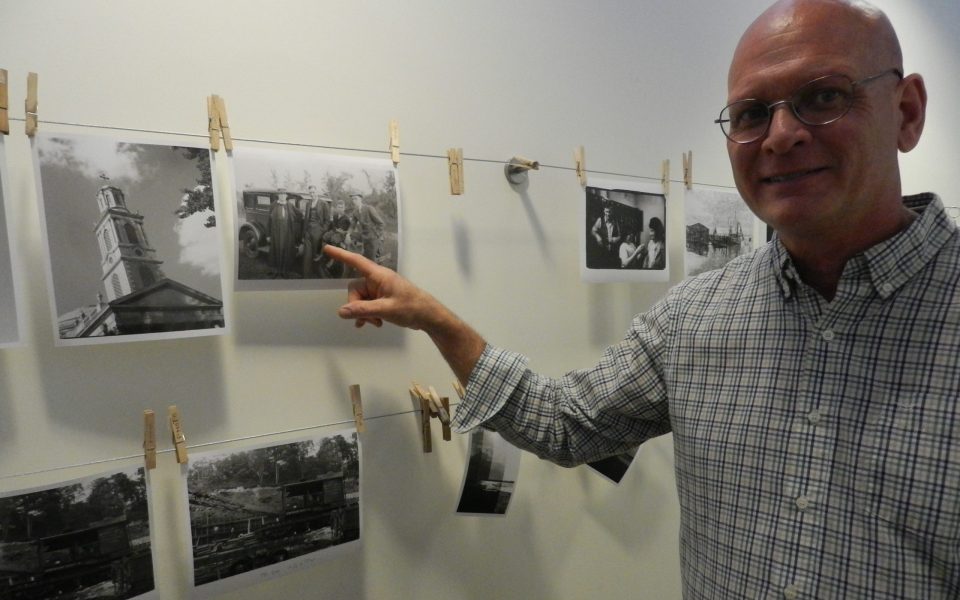It
takes a few seconds to adjust in the darkroom.
As
the door shuts, cell phones and other screens are tucked away. The light
flickers off; an orange-red glow bathes the room. Now, the magic can happen.
The
Sawtooth School for Visual Art in Winston-Salem is hosting an open house of its
darkroom on this rainy Saturday morning. Some visitors come to learn and chat,
others carry in old negatives of family photos yet to be developed.
“You
don’t learn to print film watching a YouTube video,” Dulaney says. “You have to
get your hands in some developer and mess up some paper.”
Dulaney,
an instructor at Sawtooth for the past five years, has been involved in the
practice since adolescence. Step-by-step, he shows a small tour group how to
turn a negative on a roll of film into a printed photograph, worthy of framing
and hanging on a wall.
He
takes only four or so guests into a round chamber, and grabs a bar on the wall.
He pulls the bar, rotating the walls around them. The circular wall closes off
one room and reveals a cozy film room.
“I call it the ‘“Star Trek” door,’” he jokes.
Here,
guests can lay out negatives onto a lightbox to see more clearly the pictures
they have taken. Once the negative is selected, they go back into the larger
room, to a type of projector called an enlarger.

Instructor
Bill Dent gathers a few guests around him. One attendee, Chip Bast, hands Dent
a negative, which Dent then slides into part of the enlarger. The machine
projects the image in light onto the photo paper. As the seconds, measured meticulously,
go on, the image of a bull rearing up above a bullfighter forms, and then the
lights shut off again.
The
shadows of the projection form an image so precise that the eyelashes of the
bull become visible. Bast takes the photo and places it gently into the first
of three liquids: the developer.
The
multi-chemical mixture uses a bit of silver in the paper to takes the tones
from the image and puts them in reverse: where the light carved out bright
white spaces turns a deep black. The moment the image hits the perfect point,
Bast then moves it to an acidic liquid, made to stop the picture from
over-developing. The vinegar-like scent wafts up, and the image gets put into a
final bath — called a fixer. The fixer washes off any remaining silver
particles to keep the image from fading.
“This
photo is from 1983,” Bast recalls, “in Del Rio, Texas.”
Bast
explains how that the unlucky fighter underneath the jumping bull is actually
Lane Frost, subject of the film 8 Seconds.
He looks to the print, remembering the story of taking this photo and many
others decades ago. Bast himself dabbles in both film and digital photography,
but enjoys the difficulty of getting the perfect negative, and the deliberate
and meticulous process of the darkroom.
“It slowed me down,” Bast says. “You can’t hurry.”
Athena
Kroustalis, another guest of the darkroom, agrees that the darkroom carries a
certain meditative quality.
“It
is just really zen and relaxing to be in the darkroom,” she says.
Kroustalis
places a test print down in the third bath, beside which floats another picture
with the image almost whited-out. She explains that the darkroom keeps even experienced
film photographers on their toes, trying out new strategies.
“There’s
so many variables and techniques,” she says, “so, it’s never boring.”
Dent
stands outside the darkroom, where twine and clothespins hold up finished and
drying prints from the instructors. Dent points to a figure in the center of a
vintage photograph with an old car and young men posed in front.
“My
father, which is this guy right here,” Dent says, “was a photographer.”
Like
with Dent, Dulaney’s practice feels like a tradition. Dulaney began learning
film photography at 16. Though he teaches both digital and film photography,
Dulaney thinks that creating in the darkroom adds a certain element of the
unknown.
Beside
the prints of new and vintage negatives, he hangs some test strips of different
pictures. The strips show how the photo develops when exposed to light for
varying amounts of time, becoming darker from left to right as the light was
exposed longer.
“It
all comes down to an educated guess,” Dulaney says. “I’ve got 48 years of
educated guesses.”
To learn more about Sawtooth and their classes, visit sawtooth.org.
Join the First Amendment Society, a membership that goes directly to funding TCB‘s newsroom.
We believe that reporting can save the world.
The TCB First Amendment Society recognizes the vital role of a free, unfettered press with a bundling of local experiences designed to build community, and unique engagements with our newsroom that will help you understand, and shape, local journalism’s critical role in uplifting the people in our cities.
All revenue goes directly into the newsroom as reporters’ salaries and freelance commissions.


Leave a Reply